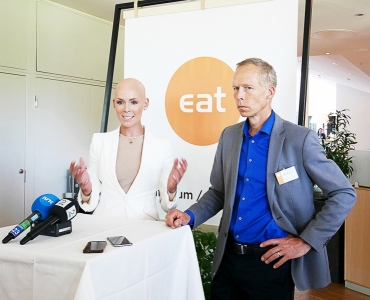The EAT Forum brought together business leaders, scientists and politicians to discuss and inspire ways to transform our food system so it doesn’t harm our health and is not too much of a burden for the environment. While listening to the talks at the event, I thought: sure, maybe not everyone is a perfect nutritionist, but at least in Sweden it’s the high prices of healthy and organic food that makes quality eating a luxury. Why is food with high environmental and negative health impacts cheap? And how this could be changed, so healthy and environmentally conscious foods become affordable?
Is green food consumption more than rich country hype?

Price difference between fullcorn organic and non-organic rice in a Swedish supermarket. Photo by Katja Bessonova.
Looking at supermarket shelves in Sweden, I am thinking of a good, simple, nutritious and not too fancy meal, which is not a hipster super-food and that is something I can cook without spending three hours in the kitchen. I am going for high standards here. I know that it is not allowed to use antibiotics in meat production for growth promotion or disease prevention in Sweden, so I choose locally produced chicken. I also pick up a package of eco-labeled rice and a bag of mixed salad leaves. And here is a EUR 16 bill for me right there. Were I to choose conventional options my bill would have been at least one third as expensive.
Food produced with considerations for environmental and human health are always more expensive than their conventional counterparts. High quality means high price, right? I buy it because I think that I can afford to care for the environment, because I care for my health, but also because it makes a good conversation with my friends and because it makes me feel better about myself. I am a typical representative of the so called green-consumer group, and maybe there aren’t enough of those to create a demand for this produce.
Digging a bit deeper into consumer behavior, according to a global survey by a New York based consultancy Nielsen, there is a trend of healthy eating, which is primarily linked to weight-loss. Consumers are demanding more “all natural” foods, indicating it is important for them to eat food rich in protein, grains, vitamins and minerals and with less salt, sugar, corn syrup and caffeine. Environmental and socioeconomic concerns play some role too – 35% of the respondents think sustainably sourced, fair-trade and/or organic ingredients are very important for their purchasing decisions, and more than 26% say local ingredients are very desirable.
It’s also interesting to see that the demand for sustainably sourced ingredients is highest in Asia-Pacific which is closely followed by Latin America. North Americans are not showing any particular preference, except a no-no to corn-syrup. In Europe health attributes are rated highest, while African and Middle Eastern consumers are looking for beneficial ingredients, such as added vitamins.
It turns out I am not so unique in my consumer behavior and that nutrition literacy is not just a Stockholm thing. What’s more, unlike one might have expected and if we trust in supply/demand, it is the consumers in the emerging economies who might be the ones to nudge the food industry into sustainability.
All that looks good, but when it comes to money, only a quarter of the respondents are willing to pay a premium for healthy and sustainably produced food. Indeed, eating eco-friendly food has become an attribute of lifestyle and, obviously, one has to pay for production with care and rigor, but it is not that intensive farming systems do not have to pay for fertilizers, pesticides and antibiotics.
 Gunhild Stordalen, EAT Initiative and Johan Rockström, SRC at the press conference during EAT 2016. Photo by Katja Bessonova.
Gunhild Stordalen, EAT Initiative and Johan Rockström, SRC at the press conference during EAT 2016. Photo by Katja Bessonova.